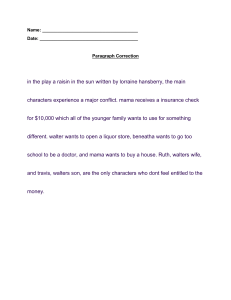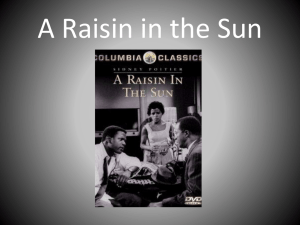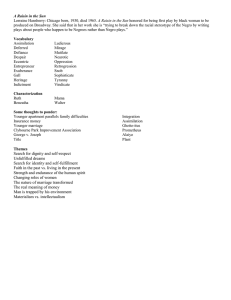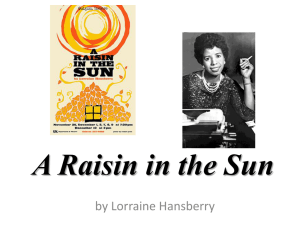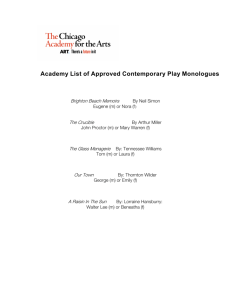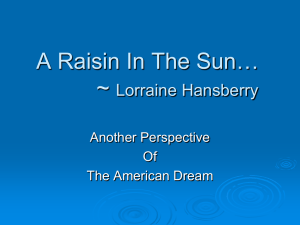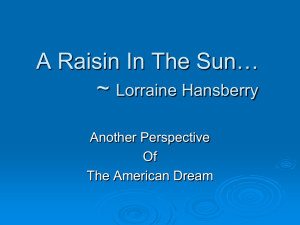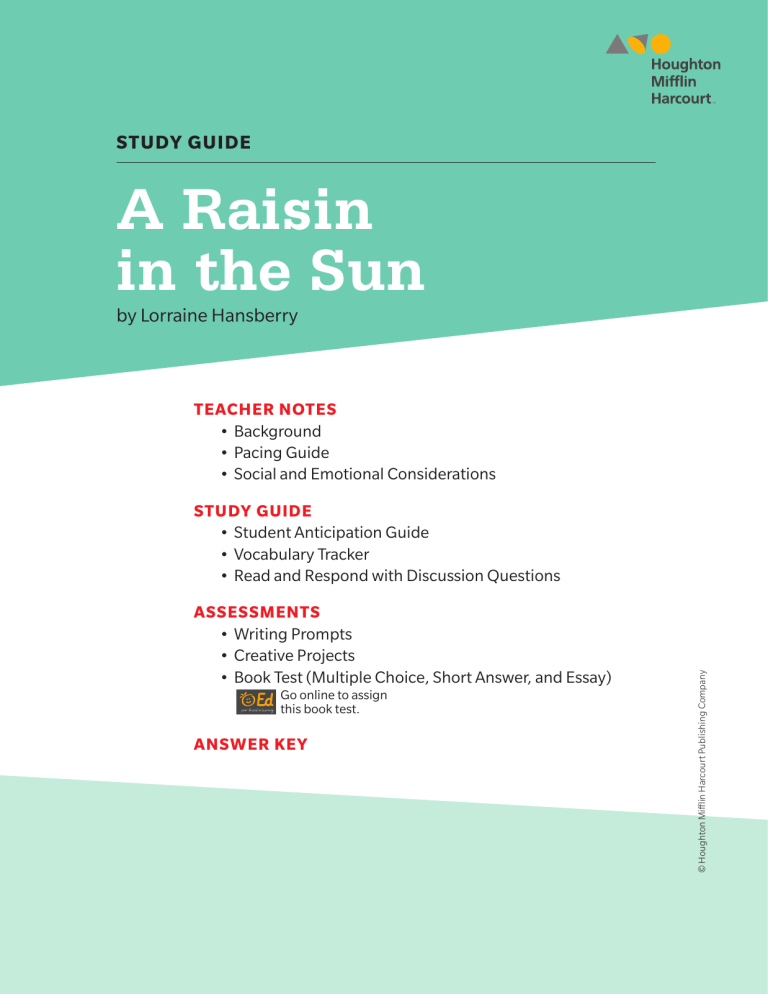
STUDY GUIDE A Raisin in the Sun by Lorraine Hansberry TEACHER NOTES • Background • Pacing Guide • Social and Emotional Considerations ASSESSMENTS • Writing Prompts • Creative Projects • Book Test (Multiple Choice, Short Answer, and Essay) Go online to assign this book test. ANSWER KEY © Houghton Mifflin Harcourt Publishing Company STUDY GUIDE • Student Anticipation Guide • Vocabulary Tracker • Read and Respond with Discussion Questions teacher notes A Raisin in the Sun by Lorraine Hansberry A Raisin in the Sun is a suggested title for Into Literature Grade 10 Unit 5. It connects to the unit’s theme and shares the unit’s Essential Question: How do changes around us reveal who we are? ABOUT THE AUTHOR Lorraine Hansberry (1930–1965) was the youngest of four children. Her parents were prominent intellectuals and political activists; and in their home in Chicago’s South Side, Hansberry met some of the greatest writers and thinkers of their generation. She was majoring in art at the University of Wisconsin when she decided to pursue a writing career and move to New York City in 1950. There, she worked for Freedom, a progressive black newspaper, and held other odd jobs while she wrote, including the beginnings of A Raisin in the Sun. A family friend raised the money to produce the play and take it to Broadway. When it opened on March 11, 1959, Hansberry became famous overnight. The New York Drama Critics Circle Award went to her that year, making her the youngest American and the first African American dramatist to receive that honor. Hansberry wrote several other plays, including The Sign in Sidney Brustein’s Window and Les Blancs. BACKGROUND This play is set in the 1950s, a time when the civil rights movement was beginning to gain momentum. Hansberry’s characters echo trends of that time, with Mama Younger (like Rosa Parks) making the powerful decision to push back against a society that views her as less than equal. Although African Americans were barred from living in certain neighborhoods and working in some professions at that time, more and more people refused to comply with these unjust restrictions. They paved the way for changes that would introduce greater equality, reshaping American society. SUMMARY A Raisin in the Sun explores issues of race in the mid-20th century through the experiences of the Younger family. Redemption from the hardships of poverty arrives in the form of a life insurance check, issued upon the death of the family’s patriarch. It is more money than the family has ever had, yet not enough to pay for everyone’s dreams. Inevitably, conflict results. Lena (Mama) Younger decides to rescue her family by buying a house—located in an all-white neighborhood. Members of the family must struggle with racism, theft, and the search for identity as they decide what their future will hold. KEY THEMES Dreams and Goals For the most part, the dreams of the major characters have been long deferred— but, ironically, when the chance for fulfillment arrives, their dreams create conflict. As a result, all of the “dreamers” must rethink the nature and the importance of their goals. The characters eventually learn that dreams can come true, but they also realize that dreams are precious and rarely come true with ease. The Power of Prejudice Reflecting the time of its writing, A Raisin in the Sun reveals a social undercurrent of racial tension. The Youngers know discrimination; in large part, it is the reason their dreams have been deferred. Prejudice in an allwhite community helps drive the play to its climax; and even in the play’s “happy ending,” the Youngers seem likely to face prejudice again. The Strength of Family The conflicts triggered by the insurance check threaten the stability of the Younger family. Along the road to resolution, family members are strengthened through personal interaction and through recognition of their responsibility to generations both past and future. Despite differences in their personalities and aspirations, they ultimately face their challenges together. © Houghton Mifflin Harcourt Publishing Company ? 2 teacher notes • A Raisin in the Sun (continued) When A Raisin in the Sun premiered, not every critic praised it. For example, poet and dramatist Amiri Baraka felt that it focused too narrowly on middle-class concerns. Over the years, however, his mind changed. Writing in 1986 about a major revival of the play, Baraka reflected that through what appears to be a traditional, rather than radical, subject and structure, Lorraine Hansberry addresses the broader concerns of how racism limits opportunities for African Americans of all classes. As students read, invite them to comment upon plot events and dialogue that reveal Hansberry’s analysis of how African Americans can resist the forces of racism and fight for a more just society. KEY LITERARY ELEMENTS Setting The setting of a play is the time and place of its action. In A Raisin in the Sun, the historical setting is the 1950s. The physical setting is the Youngers’ apartment in Chicago. Most important is this play’s social setting—the attitudes and behaviors revealed as people interact. The social setting that Hansberry creates focuses on racial prejudice and resistance to integration, but it also touches upon sexist views of women, the attempt to define an African American identity, and the role of materialism in defining success. Stage Directions A play typically includes instructions called stage directions, which usually appear in italics (and in parentheses when used within passages of dialogue). Stage directions provide information about the placement and use of props and lighting. More important, they instruct actors about when to enter and leave a scene, how to move about while on stage, and how to deliver their lines to reflect the author’s intent. As such, stage directions also can help to set a mood. Tone In drama, tone refers to the emotions and attitudes expressed in a character’s dialogue. Tone can be expressed not only in what is said but also in the way it is said. Words such as serious, humorous, formal, sarcastic, playful, and bitter may describe tone. In A Raisin in the Sun, Walter expresses an outraged tone when describing the opportunities he feels he has been denied, and he and Beneatha mock each other in a tone that sometimes is lighthearted but that sometimes turns bitter. Allusion An allusion is an indirect reference to a famous person, place, event, or literary work. The title A Raisin in the Sun is itself an allusion to its epigraph, Langston Hughes’s poem “Harlem,” and it points the audience to the play’s focus on delayed or thwarted goals. One notable allusion appears in Beneatha’s response to Lindner’s offer: “Thirty pieces and not a coin less!”—a reference to the betrayal of Jesus and thus, by implication, the Youngers’ betrayal by the system that they hoped would give them a better life. Symbol A symbol is a person, a place, an object, or an activity that stands for something beyond itself. For example, early in the play, the insurance check symbolizes seemingly unlimited opportunities for the Youngers. Later, however, Lindner’s legal papers symbolize the potential destruction of many of those opportunities. PACING GUIDE Book Introduction Read & Respond to A Raisin in the Sun DAY: 1 2–3 4–5 6 Choices & Book Test 7–8 © Houghton Mifflin Harcourt Publishing Company CRITICAL PERSPECTIVES Note: Activities in the Study Guide are provided as options. You can customize instruction according to student needs and time available. 3 teacher notes • A Raisin in the Sun (continued) Content Caution In addition to the issues that appear on the Social and Emotional Considerations chart below, there are several examples of profanity and racial epithets in the play. The play also includes mentions of abortion and alcohol abuse and the mocking of characters’ ethnic heritage. SOCIAL AND EMOTIONAL CONSIDERATIONS While most students will have positive reactions to this book, it is important to be sensitive to the few who may make connections between story events and personal trauma. The chart below lists topics or events that may trouble students, together with how the situation was resolved and ways that you might address this content with individual students. Because the chart contains plot spoilers, you may want to avoid sharing this information before students read. You may wish to share this chart with a school counselor for additional support. Sensitive Content Context Evaluating the Outcome Racial prejudice Racism has played a major part in keeping the Youngers poor. When they acquire the money to improve their situation, prejudice threatens to destroy their hope. Dealing with prejudice is a main point of the play, and the problem has no easy answers. Ask: What does Lindner mean when he tells the Youngers, “I sure hope you people know what you’re getting into”? What are some ways to deal with microaggressions or subtle racism today? Sexism Walter and George mock Beneatha for her plans to become a doctor. George also tells her that she should be pretty and simple rather than imaginative and deep. Beneatha eventually rejects George and plans to keep pursuing her dream (a dream that may take her to Africa with Asagai). Ask: Do you think that Beneatha will achieve her goal? Why or why not? How have women’s career prospects changed since the play was written? © Houghton Mifflin Harcourt Publishing Company To prepare students to engage with the book’s themes and events, have them complete the following Student Anticipation Guide before and after reading. The Before Reading and After Reading freewriting associated with the Anticipation Guide may serve as a starting point for a more in-depth discussion. 4 study guide A Raisin in the Sun by Lorraine Hansberry ? TURN AND TALK: RESPOND TO THE ESSENTIAL QUESTION With a partner, discuss your opinions and experiences related to this question: How do changes around us reveal who we are? STUDENT ANTICIPATION GUIDE Before Reading Before reading the book, mark your response to each item below in the “Before” column: • Mark a plus sign (+) if you agree. • Mark a minus sign (–) if you disagree. • Mark a question mark (?) if you are unsure of your opinion. before after 1. All people should have the chance to fulfill their dreams. 2. People often fail to recognize their own prejudices. 3. Money is often more of a curse than a blessing. 4. You can’t make people change their attitudes. 5. Your family is your best support system in life. After Reading When you have finished reading and discussing the book, mark your responses to the items above in the “After” column. Then freewrite about one item. You may choose to write about QUICK START Almost everyone fantasizes about what it might be like to come into a large amount of money. Suppose that your family suddenly received $100,000. Would everyone agree about what to do with the money? Why or why not? What would motivate their choices? Jot down your thoughts, and then discuss them with a small group of classmates. Then, as you read A Raisin in the Sun, consider what motivates the characters’ thoughts and behavior surrounding the money that comes into their lives. © Houghton Mifflin Harcourt Publishing Company • the same item you chose for your Before Reading freewriting • an item about which your opinion changed • an item about which your opinion grew much stronger 5 study guide A Raisin in the Sun by Lorraine Hansberry VOCABULARY TRACKER Use the chart below to record unfamiliar terms that you encounter while reading. Choose words that you are likely to use in future reading, writing, and class discussions in this and other classes. Page references will vary depending on the edition of the book you are reading. pretenses Page Definition from Context 24 Pretenses may be things or activities that make life more pleasant or beautiful. Dictionary Definition Appearances that hide the truth of a person or situation My New Sentence Despite their pretenses of being rich, our new neighbors were on the verge of bankruptcy. © Houghton Mifflin Harcourt Publishing Company Word 6 study guide A Raisin in the Sun by Lorraine Hansberry READ AND RESPOND 1 Act I Remember to annotate as you read. Your teacher may ask you to use sticky notes, highlight ideas, or mark and write comments on the pages. Annotating will help you find evidence to support ideas in discussions. After reading, complete the following activities. CHECK YOUR UNDERSTANDING Answer these questions independently. 1. What is Walter’s idea for using the insurance money, and why does Mama reject the idea? 2. What is Beneatha’s dream? 3. Why does Ruth faint at the end of Scene One? What does she plan to do about her situation? Review the pages you have just read and choose a sentence or short passage that you find important or thought-provoking, or one that you have a question about. Discuss it with a partner or group. TALK ABOUT THE BOOK Discuss the following questions. Use text evidence to support your answers. 1. What do you know at this point about the play’s three types of setting—historical, physical, and social? How do these settings affect the characters? 2. In what way is eating eggs a symbol to Walter? 3. What important ideas come out in the dialogue between Mama and Walter at the end of Act I? © Houghton Mifflin Harcourt Publishing Company PICK A PASSAGE 7 study guide A Raisin in the Sun by Lorraine Hansberry READ AND RESPOND 2 Act II Remember to annotate as you read. Your teacher may ask you to use sticky notes, highlight ideas, or mark and write comments on the pages. Annotating will help you find evidence to support ideas in discussions. After reading, complete the following activities. CHECK YOUR UNDERSTANDING Answer these questions independently. 1. What does Mama do with some of the money, and how do family members react? 2. How do the Youngers react to Karl Lindner’s visit? 3. What happens to the remaining money? Review the pages you have just read and choose a sentence or short passage that you find important or thought-provoking, or one that you have a question about. Discuss it with a partner or group. TALK ABOUT THE BOOK Discuss the following questions. Use text evidence to support your answers. 1. George Murchison calls Walter “Prometheus”—an allusion to Greek mythology. Look up the reference; then explain how it applies to Walter’s situation as he has just been describing it. 2. What is the Youngers’ tone toward Lindner? What ideas and experiences do you think underlie this tone? 3. Were you surprised by the ending of Act II? Why or why not? © Houghton Mifflin Harcourt Publishing Company PICK A PASSAGE 8 study guide A Raisin in the Sun by Lorraine Hansberry READ AND RESPOND 3 Act III Remember to annotate as you read. Your teacher may ask you to use sticky notes, highlight ideas, or mark and write comments on the pages. Annotating will help you find evidence to support ideas in discussions. After reading, complete the following activities. CHECK YOUR UNDERSTANDING Answer these questions independently. 1. What is Asagai’s dream for Beneatha’s future? 2. Why does Walter ask Mr. Lindner to come back to the Youngers’ apartment? 3. What does Walter tell Lindner when he arrives? PICK A PASSAGE TALK ABOUT THE BOOK Discuss the following questions. Use text evidence to support your answers. 1. When Mama admonishes Beneatha to “measure [Walter] right,” what does she mean? What factors do you take into account when you “measure” someone? 2. Mama insists that Travis stay to hear Walter’s business with Lindner. How much of an impact do you think this has on Walter, and why? 3. Review the stage directions that conclude the play. Why do you think Hansberry ended the play in this way? © Houghton Mifflin Harcourt Publishing Company Review the pages you have just read and choose a sentence or short passage that you find important or thought-provoking, or one that you have a question about. Discuss it with a partner or group. 9 assessments A Raisin in the Sun by Lorraine Hansberry CHOICES ANALYZE Choose one of the following three topics. Then write a well-organized and well-developed essay supported by evidence from A Raisin in the Sun. 1. The Langston Hughes poem that serves as the play’s epigraph begins, “What happens to a dream deferred?” At the play’s end, which dreams could still be called “deferred”? 2. What ideas about family does A Raisin in the Sun convey? Identify a theme related to family and explain how it is developed through the dialogue and action of the play. 3. The Youngers receive three visitors in Act II: George Murchison, Mrs. Johnson, and Karl Lindner. Explain how each visit is important to the plot or themes of A Raisin in the Sun. CREATE Choose one of the following three activities. 2. A Raisin Sequel When one critic said the play had a happy ending, Lorraine Hansberry disagreed with the comment, suggesting that the Youngers would face challenges in their new home. What will happen to the Youngers in Clybourne Park? On your own or with a partner, write the synopsis for a one-act sequel to A Raisin in the Sun. Try to capture the characters as you understand them. Show what has become of their dreams. Share your finished synopsis and invite comments. 3. A Drama Review A Raisin in the Sun has been filmed several times, with the original movie in 1961 and TV films in 1989 and 2008. Watch part or all of one of these productions and compare it to the text of the play. Then write and share a review of the production you watched. How does it portray the main characters? What do you think of the way it depicts the various challenges that the Youngers face? How clearly do you think it presents the themes you thought about as you read? Does it differ from the play in any important way? Be sure to cite evidence to support your thoughts. If you wish, form a panel discussion with classmates who also chose this activity and compare your opinions. © Houghton Mifflin Harcourt Publishing Company 1. Gallery Walk Work with classmates to choose several key moments from A Raisin in the Sun, one moment for each student in the group. Have each student decide how to portray her or his moment in artwork, using a variety of media. Artworks may strive for realistic accuracy or may be more abstract or impressionistic. Display the finished artworks around the classroom and have each artist stand next to his or her work. Then invite the rest of the class to visit each scene and listen to the artist’s explanation of why he or she chose that scene and the way of portraying it. 10 assessments A Raisin in the Sun by Lorraine Hansberry BOOK TEST page 1 MULTIPLE CHOICE Read each question below. Then mark the letter of the answer you have chosen. 2. What is Walter’s dream? A to buy Ruth pearls and other nice things B to open a liquor store with some friends C to send Travis to a private school D to be the kind of man Big Walter was 3. Speaking about Beneatha’s dream of becoming a doctor, Walter says that she — A makes him ashamed of being a chauffeur B isn’t smart enough for medical school C ought to be a nurse or housewife instead D ought to practice in Africa someday 4. What is the main reason for Beneatha’s interest in African culture? A her search for her identity B her romantic interest in Asagai C her college classes D her distaste for George’s ways 5. In Beneatha’s opinion, George is — A well educated and charming B handsome but too good for her C amusing and ambitious D foolish and shallow 6. Why is Walter angry when Mama buys a house? A He expected to help choose the house. B He can’t buy things for Travis. C He wanted all of the insurance money to pursue his own dream. D He fears prejudice in the new neighborhood. 7. What point does Lindner make to persuade the Youngers? A The mortgage is too high for them. B People are happier when their neighbors are people like themselves. C Their new neighbors may try to harm them. D The real estate agent is unfair. 8. Who benefits from the remaining $6,500 not spent on the house? A Beneatha, who can now afford school B Willy, who disappears with the money C Walter, who pursues his business D Ruth, who knows she can keep her baby 9. During his second meeting with Lindner, Walter changes from — A irritation to relief B bravado to embarrassment C resignation to aggression D submission to assertiveness 10. A key theme of the play is that — A family is more important than money B it is important to honor one’s heritage C hard work leads to success D all forms of discrimination are wrong © Houghton Mifflin Harcourt Publishing Company 1. A conflict takes place in Act I when — A Mama struggles with Ruth for control of the household B Travis struggles to improve his grades at school C Walter struggles with other family members over the insurance money D Beneatha struggles to choose between George and Asagai as suitors 11 assessments A Raisin in the Sun by Lorraine Hansberry BOOK TEST page 2 SHORT ANSWER Answer each of the following in complete sentences. Cite evidence from the play to support your answers. 11.The setting of a play is the time and place of its action. How do the historical and physical settings of A Raisin in the Sun enrich the play’s social setting? Consider events and ideas unlikely to occur in a more modern setting. 12. Stage directions provide information about how props and lighting should be used and about how actors should move and speak. Why do you think Hansberry goes into such detail in the stage directions that introduce each of the adult Youngers? 13. In drama, tone refers to the emotions and attitudes expressed in a character’s dialogue. In what way does the tone change from the beginning of Act III to the end of the play? What theme might this shift in tone suggest? 14. An allusion is an indirect reference to a famous person, place, event, or literary work. When Lindner makes the buyout offer, Beneatha comments, “Thirty pieces and not a coin less”—an allusion to the payment made to Judas to betray Jesus (Matthew 26:15). What does the allusion mean in the context of the play? ESSAY 16. Write an essay that explains how the Essential Question relates to the plot of A Raisin in the Sun. Discuss what the audience sees in the members of the Younger family because of the change that has come into their lives, as their story unfolds. Include evidence from the play to support your answer. ? ESSENTIAL QUESTION: How do changes around us reveal who we are? © Houghton Mifflin Harcourt Publishing Company 15. A symbol is a person, a place, an object, or an activity that stands for something beyond itself, such as an idea or a feeling. What might Mama’s potted plant symbolize? 12 answer key A Raisin in the Sun by Lorraine Hansberry ACT I Check Your Understanding 1. Walter wants to use the money to invest in a liquor store, but Mama doesn’t want to be responsible for helping people abuse alcohol. 2. Beneatha wants to become a doctor. 3. Ruth is pregnant. She is considering having an abortion because the family cannot afford a baby. ACT II Check Your Understanding 1. Mama makes a down payment on a house in an allwhite neighborhood. Family members are concerned about possible violence, and Walter is angry because he wanted to use all of the money himself. 2. Walter, Ruth, and Beneatha are polite and gracious at first. However, when they realize that Lindner has come to offer them money to stay out of Clybourne Park, they are outraged. Mama is saddened but determined to go through with the move. 3. Mama feels she has pushed Walter into despair and wants to give him a chance to handle the remaining money. Instead of setting $3000 aside for Beneatha’s education, Walter gives all of it to Willy Harris for the liquor store scheme, and Willy runs off with it. ACT III Check Your Understanding 1. Asagai wants Beneatha to marry him and go with him to Africa. 2. Walter plans to accept Lindner’s offer, take the white people’s money, and not move to Clybourne Park. 3. Walter tells Lindner that the Youngers are a simple but proud family—proud enough to reject his offer. CHOICES Analyze 1. Students may cite Walter’s dream of going into business and Beneatha’s dream of becoming a doctor. Fulfillment of the family’s dream of a better life in a new home is uncertain, because the new neighbors do not want to live near a black family. 2. Students may identify a theme such as “people gain strength from family connections.” Although the Youngers have many disagreements, in the end they support each other and face the future together. Mama reminds Walter that past generations of their family have suffered and worked to make his life possible, and that reminder helps convince him to reject Lindner’s racist offer. 3. George Murchison’s visit highlights the concept of heritage and helps to show that sexism is a form of prejudice. Mrs. Johnson’s visit reminds the audience of the dangers of challenging the status quo. Karl Lindner’s visit brings the play’s greatest challenge, asking what it takes to hold onto a dream in the face of great opposition. Create 1. You may wish to work with an art teacher to provide materials and guidance as students work. Artworks should show creative consideration of the moment chosen, and explanations should show thoughtful reflection about the activity. 2. Synopses should focus on events after the move to Clybourne Park. What the plot suggests about each character should have a reasonable connection to her or his characterization in the play. 3. Drama reviews should be well organized and have a formal tone. Details from the production should support the opinions expressed. BOOK TEST Multiple Choice 1. C 2. B 3. C 4. A 5. D 6. C 7. B 8. B 9. D 10. A Short Answer Responses will vary. Possible answers: 11. The historical setting implies that the Youngers had no significant support from the civil rights movement. The physical setting of Chicago shows that racial prejudice was not confined to the South. 12. The details help the actors understand not only how the characters look and move but also how their thoughts and feelings are being affected by their situation. 13. The tone of the characters at the beginning of Act III is dejected and defeated. As Walter speaks with Lindner, it becomes proud and righteous. By the play’s end, it is both excited and anxious about the future. One theme suggested by this shift is that we can overcome and face hardships by remaining true to our values. 14. Since Beneatha’s allusion suggests betrayal, she is commenting about the buyout offer’s betrayal of their hopes for a better life. Also, if the Youngers were to accept the offer, they would be betraying other African Americans and their struggle for equality. 15. The plant may represent the family, which cannot flourish without the opportunity to put down roots. Essay 16. Students’ essays should clearly explain how the insurance check reveals both conflicts and motivations in each of the adult Youngers. Their essays should be well supported with evidence from the play. © Houghton Mifflin Harcourt Publishing Company READ AND RESPOND Responses to Pick a Passage and Talk About the Book items will vary but should be supported with evidence from the text. 13
